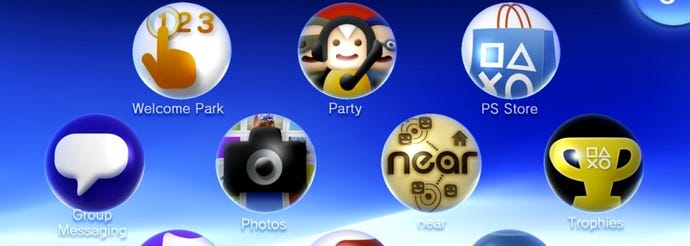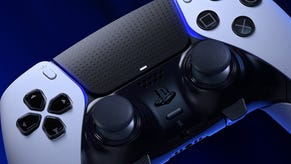PS Vita slim: what a difference a screen makes
Is there a perceptible difference between the Vita's LCD and OLED displays? Matt Martin goes hands-on with the new hardware.
Sony released the new PS Vita hardware in Japan last year, and as stock runs low in Europe, it's launching the handheld in the UK this Friday, February 7. This new version of the console is lighter, slimmer, features 1GB of built-in memory and - crucially - has switched from an OLED to an LCD display.
Those looking for a discount on the old version of the Vita are going to be disappointed - there's barely any stock left in the channel, so the latest model is simply replacing the current iteration.
So here it is, the PS Vita PCH-2003. With the change in screen technology, is there a sense that maybe this new console is an enforced, cheaper-looking iteration of existing technology?
When I first got the PS Vita almost two years ago I was stunned by the screen and the implementation of dual analog sticks on a handheld. Shortly after, like most, my interest waned until the resurgence of the console in the middle of last year, thanks to some great indie games and the Remote Play function on the PlayStation 4.
Indeed, one of the first things to notice on the new packaging is the blurb in the top right corner of the box proclaiming "Play PS4 games on the PS Vita". It's an expensive set-up to own both a Vita and a PS4, but anyone who's fortunate (and loaded) enough to use Remote Play will know what a game changer it is. It's far more than a novelty function, and although you won't be using it for Battlefield 4 multiplayer, it's a real treat for games like Don't Starve, or for chipping away at the side missions for an epic game like Assassin's Creed IV: Black Flag.
Unboxing
Out the box there's a sheet of six AR 'cards' that are actually paper, a quick start guide, the safety guide and a guarantee that, be honest, will go back in the bottom of the box never to be seen again. But - glory be! - before you unwrap the new console you'll see a good old fashioned USB cable for charging. Sony has decided to ditch the proprietary (and baffling) cable of the first Vita and has gone with something we all have in abundance. If only other gadget/phone manufacturers would take that same step.
"Fifteen percent lighter doesn't sound like much on paper but once you get the new console in your hands it's a clear difference."
Lifting the handheld out of the box it feels remarkably different - more so than I'd expected. Fifteen percent lighter doesn't sound like much on paper but once you get the new console in your hands there's a clear difference. It weighs in at 217 grams but doesn't feel flimsy (the original weighs 263 grams), with the length of the console giving you plenty to hold on to.
The sturdy build quality gives the impression it can take a few knocks and bruises, which is reassuring in today's market of cheap smartphones and dead pixels. My original Vita has travelled the globe with me and I'm not one for wrapping these things in nasty-looking third party cases. It seems as if this new iteration will take being tossed around inside an Eastpak, slid around an airport scanning tray and left hanging from a hotel power socket overnight.
The console may be 30 percent slimmer but it's not as noticeable a difference in my hands as the change in weight. The grips on the back of the system are fatter than the last build so there's a little more space for your fingers to feel resistance before slipping out into the rear touch pad. Select, Start and the PlayStation buttons are now round instead of oval and there's a curved edge that runs around the outside of the console that makes it more comfortable to hold. It might be my 80's upbringing but I actually prefer that the console is now all gloss and matt black rather than the black and silver of old.

Side by side: The old and new Vita running Killzone Mercenary.
The analog sticks, speakers, D-pad and face buttons are all in the same positions, as are the Volume and Power buttons. I'm usually quite clumsy when handling small things and have a tendency to snap anything fragile but the PS Vita card slot seems tough enough to handle my sausage fingers.
The big difference for the Vita is the change in screen display from OLED to LCD. And it is a noticeable difference when you compare the two systems side by side. I tried two different games - Killzone Mercenary and Gravity Rush - and with both I recognised deeper blacks and yellow/golds in particular on the OLED model. Blacks on the LCD display aren't washed out, but they're not nearly as dark as they should be. You can see it using the menu and general interface too, even when you mess with the brightness slider.
I also saw more motion blur with the LCD screen. The opening to the first level of Killzone Mercenary is a quick back-and-forth pan between a moving dropship, your partner and focal points in the environment, and there's a clear difference viewing it on the old and new Vita displays. During gameplay the same issue wasn't as prominent but it still bugged me during quick run and gun missions. Presumably games in development now will compensate a little for the change in hardware - but in a game this accomplished it's a disappointment.
"When you don't have the old and new Vita screens running side by side, the Vita screen stands out in its own right. It's still an incredible display."
I realise my eyes aren't a true technical test and we all have different eyesight strength, but I did get the initial feeling that we're getting an inferior screen with this update. However - and this is an important point - when you don't have the old and new Vita screens running side by side, the LCD screen stands out in its own right. It's still an incredible display - crisp, colourful and clean. It still looks and feels like a very high quality product.
Should you update?
If you're in the market for a Vita then I would recommend buying one now - move quickly and grab that old stock with the OLED display if you can (at the time of writing this 16GB version with Tearaway for £160 looks like a great deal).
If you already have the original Vita you'd be daft to sell it and upgrade to the new model. There's no point, you're not missing anything by opting for a system that's slimmer and a little bit easier to hold for long periods (once your hands are cramping from gripping the Vita it's time to put it down for a while, regardless of what model you're holding).
The change in screen display is really only apparent if you're running the OLED experience side by side, and the Vita is still such an accomplished system that you shouldn't dismiss the idea of owning one based on the shift from one screen to another. The Vita is a solid, powerful machine, it's a fantastic second screen for the PS4 and it's starting to bloom as the place for indie console games with very reasonable price points. Anyone picking up a slim Vita from Friday as their new console is likely to be equally impressed with the system and its accomplishments, regardless of a downgrade in screen technology.
Disclaimer: Sony UK supplied a PS Vita PCH-2003 for this assessment.










